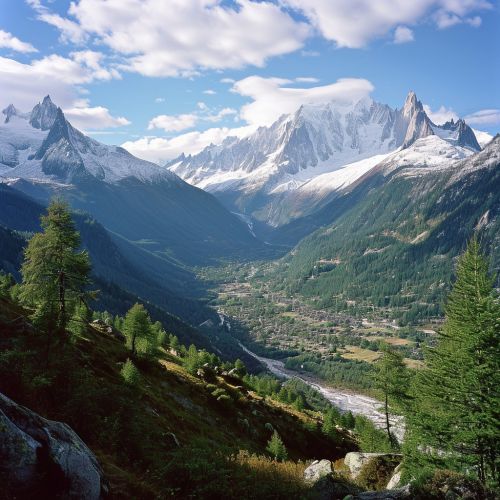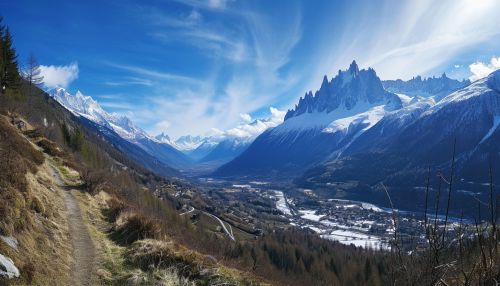Chamonix
Geography
Chamonix, officially known as Chamonix-Mont-Blanc, is a commune in the Haute-Savoie department in the Auvergne-Rhône-Alpes region in south-eastern France. It is located in the northern part of the country, near the borders with Switzerland and Italy.


The commune covers an area of 245.46 square kilometers and is situated in the heart of the French Alps, at the foot of Mont Blanc, the highest peak in Western Europe. The valley in which Chamonix is located is surrounded by several other high peaks, including Aiguille du Midi and Les Drus, which are part of the Mont Blanc massif.
History
The history of Chamonix dates back to the Neolithic period, with evidence of early human settlement in the area. However, it was not until the 18th century that the region began to gain prominence as a tourist destination, following the first recorded ascent of Mont Blanc by Jacques Balmat and Michel Paccard in 1786. This event marked the birth of mountaineering, a sport that has since become synonymous with Chamonix.
In the 19th century, Chamonix continued to grow as a resort town, with the construction of hotels and the arrival of the railway. The town's status as a premier mountain resort was further cemented in 1924 when it hosted the first Winter Olympic Games.
Climate
Chamonix has a temperate climate, with warm summers and cold, snowy winters. The town's high altitude and location in the Alps result in significant snowfall during the winter months, making it a popular destination for winter sports such as skiing and snowboarding. The summer months, while warmer, are still relatively cool, with average temperatures rarely exceeding 20 degrees Celsius.
Economy
The economy of Chamonix is largely driven by tourism, with the town attracting millions of visitors each year. The primary draw is the opportunity for outdoor activities, particularly skiing and mountaineering. The town is home to several ski resorts, including the Chamonix Valley ski area, which is one of the oldest in France.
In addition to tourism, Chamonix also has a small agricultural sector, with local farms producing products such as cheese and honey. The town is also home to a number of small businesses and shops, many of which cater to the tourist trade.
Culture
Chamonix has a rich cultural heritage, with a number of annual festivals and events. These include the Chamonix Unlimited Festival, a music festival held in April, and the Chamonix Adventure Festival, which showcases adventure films from around the world.
The town is also home to several museums, including the Musée Alpin, which documents the history and culture of the Alps, and the Espace Tairraz, a museum of crystals and alpinism.
Transport
Chamonix is well connected by road and rail. The town is located on the Route Blanche, a major highway that connects Geneva in Switzerland with Turin in Italy. Chamonix also has a railway station, which is served by the Mont Blanc Express, a regional train service that connects the town with other destinations in the region.
In addition to road and rail, Chamonix is also accessible by air, with the nearest airport located in Geneva, approximately 80 kilometers away.
